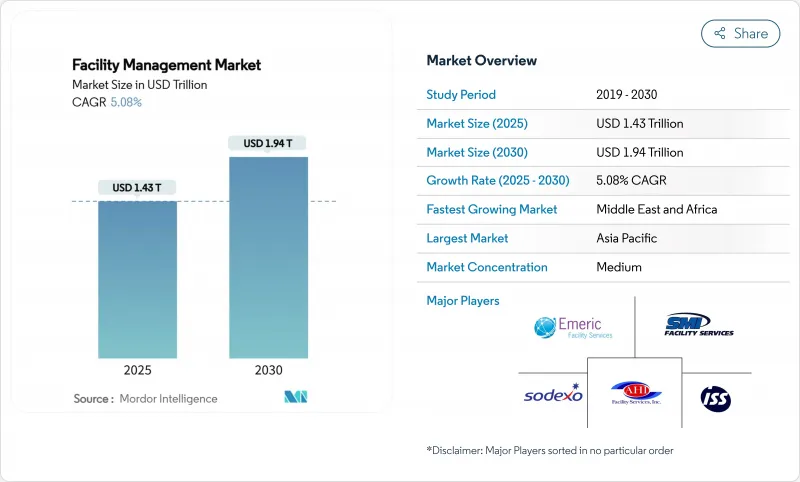
|
市場調査レポート
商品コード
1851359
ファシリティマネジメント:市場シェア分析、産業動向、統計、成長予測(2025年~2030年)Facility Management - Market Share Analysis, Industry Trends & Statistics, Growth Forecasts (2025 - 2030) |
||||||
カスタマイズ可能
適宜更新あり
|
|||||||
| ファシリティマネジメント:市場シェア分析、産業動向、統計、成長予測(2025年~2030年) |
|
出版日: 2025年07月11日
発行: Mordor Intelligence
ページ情報: 英文 172 Pages
納期: 2~3営業日
|
概要
ファシリティマネジメント市場規模は2025年に1兆5,170億米ドルと推定・予測され、2030年には1兆9,430億米ドルに達すると予測されます。

成長の勢いは、ファシリティマネジメントがサポートコストから、オペレーションの回復力、デジタル統合、従業員の生産性を向上させる戦略的テコとして位置づけられたことを反映しています。アウトソーシング意欲の高まり、サイバーセキュリティ事件にもかかわらずクラウドへの移行が急速に進んでいること、ESGの義務化が着実に進んでいることなどが、総じて対応可能な需要を拡大しています。新興市場、特にアジア太平洋地域におけるインフラ支出の増加は、ファシリティマネジメント市場の多地域的な拡大サイクルを強化しています。透明性の高いコスト管理と測定可能な効率性を顧客が求める中、テクノロジー・プラットフォームと成果ベースのモデルを融合させたプロバイダーがプレミアム契約を獲得しています。
世界のファシリティマネジメント市場の動向と洞察
非中核業務のアウトソーシング重視の高まり
企業の35%が2024年にFM予算を増額し、オペレーションの複雑さを抑制します。ファシリティマネジメント市場は、プロバイダーがサプライチェーンのショックを吸収し、多様な労働力を提供するスケール効果の恩恵を受けています。テクノロジーとヘルスケアにおける需要は顕著で、CBREの2025年第1四半期のファシリティ契約による純収入の16%増を支えています。また、サプライヤーのリスク・エクスポージャーを軽減する効果もあり、29%の企業が混乱への懸念を示し、ロジスティクスを強化したFMパートナーへの選好を高めています。アウトソーシング量が増加するにつれ、プロバイダーは利幅を自動化、予測分析、労働力のスキルアップに再投資しており、ファシリティマネジメント市場全体で好循環の成長サイクルが強化されています。
IoT対応予知保全による設備のデジタル化
予知保全プラットフォームは2025年に55億米ドル規模に達し、毎年17%ずつ拡大しています。ヘルスケアの採用企業では、作業指示の自動生成により10~15%の設備コスト削減が報告されています。ソフトウェア・レイヤーは支出額の44%を占め、ファシリティマネジメント市場内の中規模施設向けにアクセスを民主化する事前訓練済みアルゴリズムをパッケージ化しています。産業プラントの初期試験で、廃熱の回収が25%速くなったことが明らかになり、ESGの具体的な利益が浮き彫りになりました。異常検知モデルが成熟するにつれて、データの前提条件が緩和され、小規模な資産であれば、過去の膨大なログがなくても市場参入が可能になり、地域間の市場浸透が進みます。
ファシリティマネジメント労働における高賃金インフレ
設備サポートの平均時給は2024年に4.1%上昇し、中央値で21.74米ドルとなり、労働集約的な契約の利幅が縮小します。コーネル大学の施設労働者のストライキのような出来事は、組合活動の高まりを裏付けるものです。隠された契約料やバックエンドの追加料金はさらに予算を圧迫し、バイヤーはアウトソーシングの経済性を再考せざるを得なくなります。プロバイダーは、ロボットや自律清掃の試験運用を加速させることで対応しているが、先行投資や再教育の要件が、ファシリティマネジメント市場全体における当面の採用の重荷となっています。
セグメント分析
ハードサービスは2024年のファシリティマネジメント市場規模の59.0%を占め、資産の完全性を守る機械・電気・配管(MEP)メンテナンスの義務化が後押ししています。規制基準や資産の複雑化に伴い、認定技術者が必要となり、需要の安定性が強化されます。予測期間中、顧客が統合されたエクスペリエンス管理を求めるにつれて、ソフトサービスとの融合が強まり、統合ベンダーにクロスセリングの道が生まれます。
ソフトサービスの規模は小さいもの、CAGR 6.30%で加速しており、衛生、セキュリティ、居住者の福利厚生への関心の高まりを反映しています。清掃契約には抗菌プロトコルとロボット掃除機が組み込まれ、セキュリティはAIビデオ分析にシフトしています。ESGスコアカードが室内空気やケータリングの持続可能性にまで拡大する中、ソフトサービスは取締役会レベルの可視性を獲得しています。ハードとソフトのデータストリームを融合させるプロバイダーは、予防スケジュールを積極的に調整することができ、具体的な業務上の利益を生み出し、ファシリティマネジメント市場においてウォレットシェアを拡大します。
2024年のファシリティマネジメント市場シェアの53.81%はインハウスモデルであり、説明責任を合理化する統合FM(IFM)契約に支えられています。マルチサイト企業は、単一請求書による透明性を高く評価し、普及を促進しています。同時に、アウトソーシングFMは、サイバーに敏感な業界が重要な管理を維持する中、CAGR 5.96%で拡大。戦略的計画は社内にとどめ、現場での実行はパートナーに移し、柔軟性とリスクのバランスをとるというハイブリッド構造が普及しています。
IFMの範囲が拡大するにつれて、ベンダーは分析ポータルを組み込み、場所ごとのサービスコストを表示し、データ主導の更新を可能にします。クライアントがトータルバリューの提案を強く求め、小規模なコントラクターが合併やニッチな分野に特化するようになるにつれ、シングルサービスの選択肢は減少しています。CBREによる16億米ドルのIndustrious買収は、施設、ホスピタリティ、スペース分析をバンドルしたエクスペリエンス型サブスクリプションに向けた戦略的な再配置を明確にし、これにより市場競争の輪郭を再定義しています。
地域分析
アジア太平洋地域は、2024年のファシリティマネジメント市場の41.26%を占め、政府の景気刺激策と都市部への移住に支えられ、CAGR 6.28%で拡大する見込みです。中国の51兆4,000億米ドルの固定資産投資は、5.9%のインフラ投資を含め、長期的なサービスパイプラインの下支えとなっています。インドでは商業用不動産が急増し、遠隔監視の需要が高まる一方、ASEANのスマートシティ計画ではFM契約が基本計画の段階に組み込まれます。ローカライズされたサプライチェーンと多言語プラットフォームを展開するプロバイダーは、早い段階から優位に立つことができると思われます。
北米は成熟しつつも革新的な状況を維持しており、クラウドの普及とESGコンプライアンスがプレミアム料金を牽引しています。同地域のファシリティマネジメント市場は、逼迫した労働力プールに直面し、自動化の導入に拍車をかけています。エネルギー最適化の義務化とインフレ抑制法のインセンティブにより、FMの専門家が管理する改修が奨励されています。欧州も同様にデジタル化が進んでいるが、EPBDのような厳しい炭素規制があり、契約はパフォーマンス連動型報酬に誘導されています。欧州全体のベンダーは、国境を越えたガバナンスの枠組みを活用し、サービスの質を標準化しています。
中東とアフリカでは、交通、ヘルスケア、教育インフラで官民パートナーシップによる導入が加速しています。湾岸協力会議の巨大プロジェクトでは、設計段階からFMの規定を統合し、ライフサイクル価値を高めています。南米では、ロジスティクスや製造業の拡大に伴う安定した需要があるが、為替変動により柔軟な価格設定が必要となります。新興地域全体では、サプライヤーが断片化しているため、合併統合を得意とするグローバル・メジャーにとって、市場情勢は拡大傾向にあります。
その他の特典:
- エクセル形式の市場予測(ME)シート
- 3ヶ月間のアナリストサポート
よくあるご質問
目次
第1章 イントロダクション
- 調査の前提条件と市場の定義
- 調査範囲
第2章 調査手法
第3章 エグゼクティブサマリー
第4章 市場情勢
- 市場概要
- 市場促進要因
- 非中核事業のアウトソーシング重視の高まり
- IoT対応予知保全による設備のデジタル化
- サステナビリティとESG連動型FM契約
- パンデミック後のハイブリッドワークプレイス再設計の必要性
- 新興国における官民インフラパイプライン
- AI主導のエネルギー最適化指令
- 市場抑制要因
- 清掃労働における高賃金インフレ
- 新興市場におけるベンダー基盤の断片化
- クラウドベースのFMプラットフォームにおけるサイバーセキュリティリスク
- 中小企業におけるIFMプラットフォームの資本ロックイン
- バリューチェーン分析
- 規制情勢
- テクノロジーの展望
- ポーターのファイブフォース分析
- 供給企業の交渉力
- 買い手の交渉力
- 新規参入業者の脅威
- 代替品の脅威
- 競争企業間の敵対関係
- 価格分析
- 市場のマクロ経済動向の評価
第5章 市場規模と成長予測
- サービスタイプ別
- ハードサービス
- アセット・マネジメント
- MEPおよびHVAC
- 火災と安全
- その他のハード・サービス
- ソフトサービス
- クリーニング
- セキュリティとオフィスサポート
- ケータリング
- その他ソフトサービス
- ハードサービス
- 提供タイプ別
- インハウス
- アウトソーシング
- シングルサービスFM
- バンドルFM
- 統合FM(IFM)
- 展開モデル別
- オンプレミス
- クラウドベース
- 企業規模別
- 大企業
- 中小企業(SMEs)
- エンドユーザー業界別
- 商業(IT/テレコム、小売、倉庫)
- ホスピタリティ(ホテル、レストラン)
- 制度・公共インフラ
- ヘルスケア
- 工業用およびプロセス
- 住宅とレジャー
- 地域別
- 北米
- 米国
- カナダ
- メキシコ
- 欧州
- 英国
- ドイツ
- フランス
- イタリア
- スペイン
- ベネルクス(ベルギー、オランダ、ルクセンブルク)
- 北欧(スウェーデン、ノルウェー、デンマーク、フィンランド)
- ポーランド
- ロシア
- その他欧州地域
- アジア太平洋地域
- 中国
- インド
- 日本
- 韓国
- オーストラリアおよびニュージーランド
- その他アジア太平洋地域
- 南米
- ブラジル
- アルゼンチン
- コロンビア
- チリ
- その他南米
- 中東・アフリカ
- 中東
- GCC(サウジアラビア、UAE、カタール、オマーン、クウェート、バーレーン)
- トルコ
- その他中東
- アフリカ
- 南アフリカ
- ナイジェリア
- エジプト
- ケニア
- その他アフリカ
- 北米
第6章 競合情勢
- 市場集中度
- 戦略的動向
- 市場シェア分析
- 企業プロファイル
- CBRE Group Inc.
- Cushman and Wakefield plc
- JLL(Jones Lang LaSalle Inc.)
- ISS A/S
- Sodexo SA
- Compass Group plc
- Emeric Facility Services
- SMI Facility Services
- AHI Facility Services Inc.
- Aramark Corporation
- ABM Industries Inc.
- G4S Limited
- Atalian Global Services
- Vinci Facilities(VINCI SA)
- EMCOR Group Inc.
- Comfort Systems USA
- Balfour Beatty-Workplace
- Serco Group plc
- Reliance Facilities(India)
- Sinopec Engineering FM(China)
- Unispace Global

